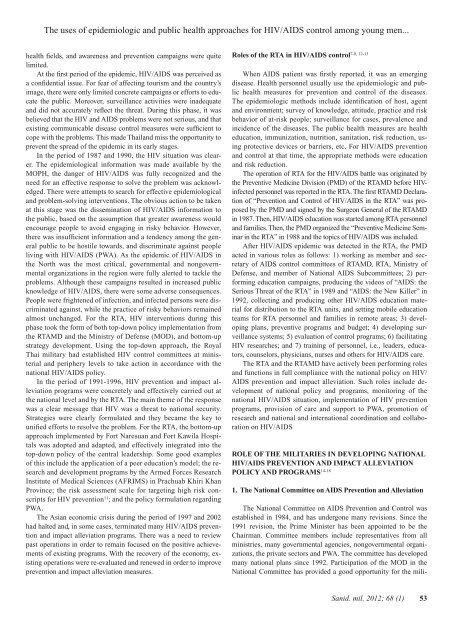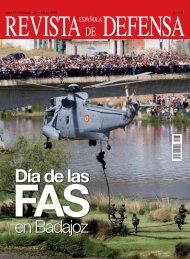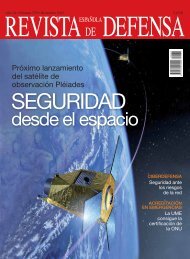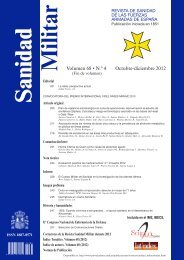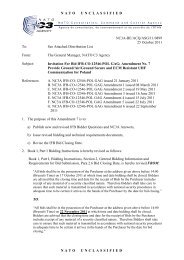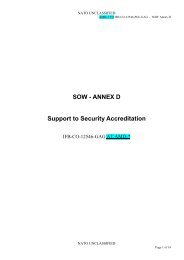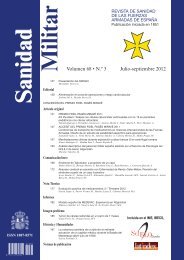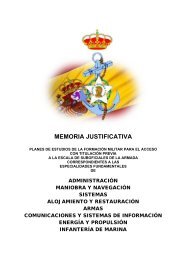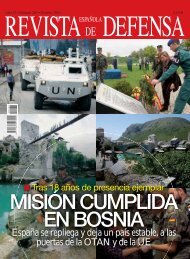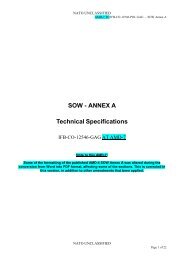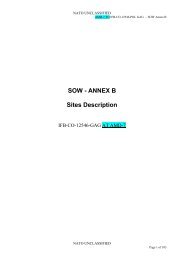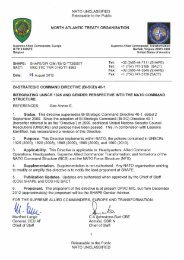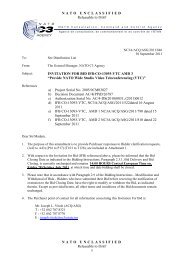Sanidad Militar - Ministerio de Defensa
Sanidad Militar - Ministerio de Defensa
Sanidad Militar - Ministerio de Defensa
Create successful ePaper yourself
Turn your PDF publications into a flip-book with our unique Google optimized e-Paper software.
The uses of epi<strong>de</strong>miologic and public health approaches for HIV/AIDS control among young men...<br />
health fields, and awareness and prevention campaigns were quite<br />
limited.<br />
At the first period of the epi<strong>de</strong>mic, HIV/AIDS was perceived as<br />
a confi<strong>de</strong>ntial issue. For fear of affecting tourism and the country’s<br />
image, there were only limited concrete campaigns or efforts to educate<br />
the public. Moreover, surveillance activities were ina<strong>de</strong>quate<br />
and did not accurately reflect the threat. During this phase, it was<br />
believed that the HIV and AIDS problems were not serious, and that<br />
existing communicable disease control measures were sufficient to<br />
cope with the problems. This ma<strong>de</strong> Thailand miss the opportunity to<br />
prevent the spread of the epi<strong>de</strong>mic in its early stages.<br />
In the period of 1987 and 1990, the HIV situation was clearer.<br />
The epi<strong>de</strong>miological information was ma<strong>de</strong> available by the<br />
MOPH, the danger of HIV/AIDS was fully recognized and the<br />
need for an effective response to solve the problem was acknowledged.<br />
There were attempts to search for effective epi<strong>de</strong>miological<br />
and problem-solving interventions. The obvious action to be taken<br />
at this stage was the dissemination of HIV/AIDS information to<br />
the public, based on the assumption that greater awareness would<br />
encourage people to avoid engaging in risky behavior. However,<br />
there was insufficient information and a ten<strong>de</strong>ncy among the general<br />
public to be hostile towards, and discriminate against people<br />
living with HIV/AIDS (PWA). As the epi<strong>de</strong>mic of HIV/AIDS in<br />
the North was the most critical, governmental and nongovernmental<br />
organizations in the region were fully alerted to tackle the<br />
problems. Although these campaigns resulted in increased public<br />
knowledge of HIV/AIDS, there were some adverse consequences.<br />
People were frightened of infection, and infected persons were discriminated<br />
against, while the practice of risky behaviors remained<br />
almost unchanged. For the RTA, HIV interventions during this<br />
phase took the form of both top-down policy implementation from<br />
the RTAMD and the Ministry of Defense (MOD), and bottom-up<br />
strategy <strong>de</strong>velopment. Using the top-down approach, the Royal<br />
Thai military had established HIV control committees at ministerial<br />
and periphery levels to take action in accordance with the<br />
national HIV/AIDS policy.<br />
In the period of 1991-1996, HIV prevention and impact alleviation<br />
programs were concretely and effectively carried out at<br />
the national level and by the RTA. The main theme of the response<br />
was a clear message that HIV was a threat to national security.<br />
Strategies were clearly formulated and they became the key to<br />
unified efforts to resolve the problem. For the RTA, the bottom-up<br />
approach implemented by Fort Naresuan and Fort Kawila Hospitals<br />
was adopted and adapted, and effectively integrated into the<br />
top-down policy of the central lea<strong>de</strong>rship. Some good examples<br />
of this inclu<strong>de</strong> the application of a peer education’s mo<strong>de</strong>l; the research<br />
and <strong>de</strong>velopment programs by the Armed Forces Research<br />
Institute of Medical Sciences (AFRIMS) in Prachuab Khiri Khan<br />
Province; the risk assessment scale for targeting high risk conscripts<br />
for HIV prevention 11 ; and the policy formulation regarding<br />
PWA.<br />
The Asian economic crisis during the period of 1997 and 2002<br />
had halted and, in some cases, terminated many HIV/AIDS prevention<br />
and impact alleviation programs. There was a need to review<br />
past operations in or<strong>de</strong>r to remain focused on the positive achievements<br />
of existing programs. With the recovery of the economy, existing<br />
operations were re-evaluated and renewed in or<strong>de</strong>r to improve<br />
prevention and impact alleviation measures.<br />
7-8, 12-13<br />
Roles of the RTA in HIV/AIDS control<br />
When AIDS patient was firstly reported, it was an emerging<br />
disease. Health personnel usually use the epi<strong>de</strong>miologic and public<br />
health measures for prevention and control of the diseases.<br />
The epi<strong>de</strong>miologic methods inclu<strong>de</strong> i<strong>de</strong>ntification of host, agent<br />
and environment; survey of knowledge, attitu<strong>de</strong>, practice and risk<br />
behavior of at-risk people; surveillance for cases, prevalence and<br />
inci<strong>de</strong>nce of the diseases. The public health measures are health<br />
education, immunization, nutrition, sanitation, risk reduction, using<br />
protective <strong>de</strong>vices or barriers, etc. For HIV/AIDS prevention<br />
and control at that time, the appropriate methods were education<br />
and risk reduction.<br />
The operation of RTA for the HIV/AIDS battle was originated by<br />
the Preventive Medicine Division (PMD) of the RTAMD before HIVinfected<br />
personnel was reported in the RTA. The first RTAMD Declaration<br />
of “Prevention and Control of HIV/AIDS in the RTA” was proposed<br />
by the PMD and signed by the Surgeon General of the RTAMD<br />
in 1987. Then, HIV/AIDS education was started among RTA personnel<br />
and families. Then, the PMD organized the “Preventive Medicine Seminar<br />
in the RTA” in 1988 and the topics of HIV/AIDS was inclu<strong>de</strong>d.<br />
After HIV/AIDS epi<strong>de</strong>mic was <strong>de</strong>tected in the RTA, the PMD<br />
acted in various roles as follows: 1) working as member and secretary<br />
of AIDS control committees of RTAMD, RTA, Ministry of<br />
Defense, and member of National AIDS Subcommittees; 2) performing<br />
education campaigns, producing the vi<strong>de</strong>os of “AIDS: the<br />
Serious Threat of the RTA” in 1989 and “AIDS: the New Killer” in<br />
1992, collecting and producing other HIV/AIDS education material<br />
for distribution to the RTA units, and setting mobile education<br />
teams for RTA personnel and families in remote areas; 3) <strong>de</strong>veloping<br />
plans, preventive programs and budget; 4) <strong>de</strong>veloping surveillance<br />
systems; 5) evaluation of control programs; 6) facilitating<br />
HIV researches; and 7) training of personnel, i.e., lea<strong>de</strong>rs, educators,<br />
counselors, physicians, nurses and others for HIV/AIDS care.<br />
The RTA and the RTAMD have actively been performing roles<br />
and functions in full compliance with the national policy on HIV/<br />
AIDS prevention and impact alleviation. Such roles inclu<strong>de</strong> <strong>de</strong>velopment<br />
of national policy and programs, monitoring of the<br />
national HIV/AIDS situation, implementation of HIV prevention<br />
programs, provision of care and support to PWA, promotion of<br />
research and national and international coordination and collaboration<br />
on HIV/AIDS<br />
ROLE OF THE MILITARIES IN DEVELOPING NATIONAL<br />
HIV/AIDS PREVENTION AND IMPACT ALLEVIATION<br />
POLICY AND PROGRAMS 14-18<br />
1. The National Committee on AIDS Prevention and Alleviation<br />
The National Committee on AIDS Prevention and Control was<br />
established in 1984, and has un<strong>de</strong>rgone many revisions. Since the<br />
1991 revision, the Prime Minister has been appointed to be the<br />
Chairman. Committee members inclu<strong>de</strong> representatives from all<br />
ministries, many governmental agencies, nongovernmental organizations,<br />
the private sectors and PWA. The committee has <strong>de</strong>veloped<br />
many national plans since 1992. Participation of the MOD in the<br />
National Committee has provi<strong>de</strong>d a good opportunity for the mili-<br />
Sanid. mil. 2012; 68 (1) 53


